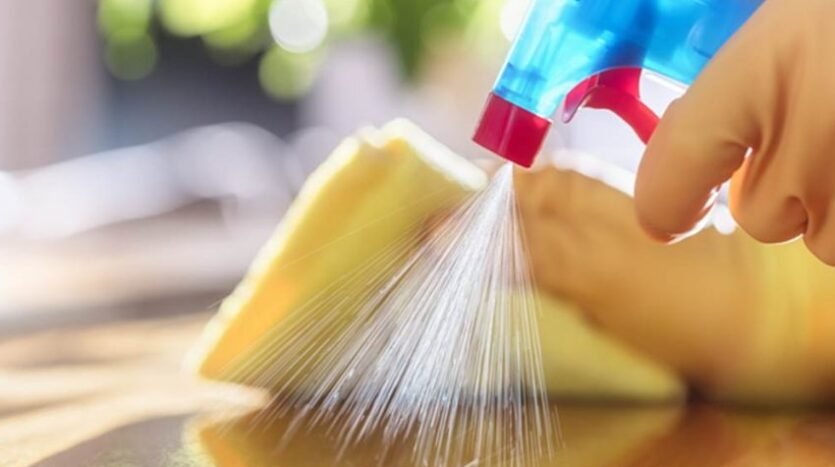How to disinfect yourself, houses and commercial spaces against covid-19
With the current outbreak of COVID-19, frequently cleaning and disinfecting your home is essential for keeping yourself and your family safe and healthy.
The Centers for Disease Control (CDC) recommends cleaning and disinfecting high-touch surfaces at least once a day, even if you’re not leaving the house. That’s because anytime items or people come in and out of your home, there’s some possibility of exposure.
A recent study found that the novel coronavirus can remain in the air for up to three hours and live on surfaces such as cardboard for up to 24 hours, and plastic and stainless steel for up to three days.
Here are a few ways to make sure you are properly cleaning and disinfecting your home and keeping your household as germ-free as possible.
The Difference Between Cleaning and Disinfecting
It’s important to note that cleaning a surface – simply removing dirt and particles – is not the same thing as disinfecting it to kill viruses and bacteria.
There are many products you can use to clean hard surfaces, like soapy water and vinegar. And while cleaning high-traffic surfaces to remove contaminants, dust and debris is a necessary step of cleaning your home, you still need to disinfect those surfaces from the novel coronavirus.
Current evidence suggests that SARS-CoV-2 (Covid-19) may remain viable for hours to days on surfaces made from a variety of materials. Cleaning of visibly dirty surfaces followed by disinfection is a best practice measure for prevention of COVID-19 and other viral respiratory illnesses in households and community settings.
Which Cleaning Products Kill COVID-19?
Not all cleaning products are effective on all types of germs, so you should know exactly which products kill COVID-19.
The EPA provides a full list of disinfectants that kill the novel coronavirus. You might already have some of these effective products in your home, like:
- Chlorine dioxide based disinfectants such as oxine, vitaloxide etc.
- Disinfecting wipes, including Clorox, Lysol or store brand wipes
- Disinfectant sprays, such as Purell, Clorox or Lysol
- Isopropyl alcohol
- Hydrogen peroxide
And while using effective virus-killing products is key, it’s also important to follow the proper techniques to thoroughly disinfect surfaces. The EPA advises letting the product sit and remain wet on surfaces or objects for 10 minutes, and that will kill 99.9 percent of germs.
If you don’t have any disinfecting products on hand and are unable to find any in stores, the CDC offers instructions how to create a homemade bleach disinfectant spray.
Caution
If you use this product, be sure to wear gloves, open your windows and be careful since bleach can damage or discolor sensitive surfaces.
Which is the best disinfectant
As per hospitalhealth.com
Choosing a disinfectant for both medical devices and surfaces can be confusing. With so many different chemistries, modes of action, contact times, delivery methods, OH&S profiles and microbiological efficacies on offer, how do you select the right product?
Chlorine dioxide (ClO2) has been used for decades as an effective disinfectant in a wide range of industries and is fast gaining recognition in the healthcare industry with an unparalleled reputation.
ClO2 outperforms alternative chemistries, providing superior disinfection that can be tailored for various applications. Effective in exceptionally short contact times at lower concentrations, chlorine dioxide demonstrates a good safety profile whilst maintaining efficacy.
This makes it an ideal chemistry for use in healthcare, where fast, effective and simple disinfection is paramount.
What is chlorine dioxide?
Chlorine dioxide is an unusual molecule with structural bonding once thought to be impossible. The chlorine atom requires more bonds that it can physically withstand, which causes one of the electrons to be in constant exchange between the two oxygen atoms. This electron exchange is called Resonance and is the key reason why this chemistry is so unique. This constant vibration is a causative for why the oxidising agent can boast a broad-spectrum efficacy including bacteria, yeast, fungi, viruses, mycobacteria, protozoa and bacterial spores. Furthermore, microorganisms cannot build resistance to chlorine dioxide.
Surface disinfection
Chlorine dioxide is 263% more effective than conventional chlorine solution, one of the most commonly used surface disinfectants worldwide.
Other chemistries such as alcohols or quaternary ammonium compounds (QACs) can provide reasonable efficacy against bacteria and fungi, but they are far less effective against viruses and mycobacteria and have no credible efficacy against bacterial spores in acceptable contact times.
Many disinfectant chemistries will successfully pass efficacy tests when tested under specific parameters. These can include clean or dirty conditions, cold or warm temperatures, extended contact times and high volumes of disinfectant liquid, meaning the tests are not always representative of real-life scenarios. Chlorine dioxide is effective within realistic user parameters.
Device disinfection
Oxidising agents such as ClO2 are typically chosen for device disinfection due to their speed and broad-spectrum efficacy. However, substitute chemistries such as hydrogen peroxide and peracetic acid are known to be corrosive and potentially hazardous. Medical devices have been successfully validated for disinfection using chlorine dioxide at ambient temperatures and low concentrations. Resulting in a safer user environment, and a longer life for the medical device itself.
Fruit and vegetables disinfection
Chlorine dioxide is regularly used for washing and disinfecting fruits and vegetables at home or for comemrcial purpose. It is approved by NSF, National sanitation foundation .
This means that after you wash your vegetables and fruits all you have to do it spray it with the Clo2 solution as per the recommended dose and you can consume without having to wash it again.
Chlorine dioxide can be used on food-contact surfaces at diluted concentrations as low as 5 parts-per-million (ppm). In some cases, the compound has demonstrated a rapid kill of bacteria much less than the 30-minute period typically used in disinfection studies. Because it is so powerful in such small amounts, it is also extremely economical.
Personal sanitation
Chlorine dioxide solution can easily be used for disinfectant tunnels or hand santizers. It is much safer to use on skin and has hardly any side effects in addition it is dirt cheap compared to hand sanitizers available in the market.
How to get Chlorine dioxide?
It is not available in Pakistan as a retail product and is only used in areas which require highly efficient disinfectants such as poultry, health faciitues, food processing plants etc. We were able to trace down the suppliers Vetson Pvt Ltd who bulk import this from United states by the name of Safe Dutrion in Pakistan.
Good thing is that in the present circumstances they have made it available for the house hold users at a very cheap price. You can use this product for following:
- Hand santizer
- Spraying
- Moppping
- Fumigation
Not only it is dirt cheap in comparision to commercial disinfectants it is also many times more effective and safer for your health.
https://www.youtube.com/watch?v=7VGluLqM08Q
Disinfecting Against COVID-19
You don’t need to clean your house from top to bottom each day, but you should focus on disinfecting the areas that are hot-spots for germs. These are the most important items to disinfect every day:
- Cupboard and drawer knobs/pulls
- Faucets
- Kitchen and bathroom counters
- Toilets, especially the seat and handle
- Refrigerator, dishwasher, oven and microwave handles
- Remote controls and game controllers
- Cell phones, tablets and other mobile devices
- Computer keyboards and mice
- Door knobs/handles
- Table surfaces
- Staircase railings
- Light switches/switch plates
If possible, wear disposable gloves and discard them after disinfecting. If you have reusable gloves, be sure to disinfect them after you’re done. And always remember to wash your hands before and after you clean and disinfect your home.
How to Clean and Disinfect If You Have a Sick Person In Your Home
If you have a sick person in your home, the CDC recommends taking extra precautions to clean and disinfect your household areas.
The person who is sick should stay separated from other people in the home and use a separate bedroom and bathroom, if possible. You should only clean and disinfect the area around the person who is sick when needed, such as when the area is soiled. This will help limit your contact with the person who is sick.
If possible, you can provide cleaning supplies to the person who is sick so they can clean their own space if they’re able. If you are sharing a bathroom with a sick person, they should clean and disinfect the space after each use. If this is not possible, you should wait as long as possible before cleaning and disinfecting.
Keep Washing Your Hands
It’s been repeated countless times, but that’s because it’s true: no matter what you do, the best way to lower your risk of contracting COVID-19 or passing it to someone else is to wash your hands.
The CDC recommends a vigorous 20-second scrub with soap and water that extends beyond the hands to the wrists, between the fingers and under the fingernails.

